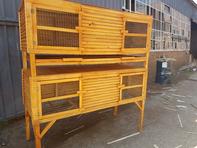Material for Rabbit Cages
Most rabbit cages are made from galvanised chicken wire as wire cages are easy to clean but these cages it must be placed either in a building or under a roof structure.

The floor wire should be 25 x 12.5 mm in size and the wire for the sides can be either 25 x 25 mm or even 25 x 50 mm. Wooden rabbit hutches (with roof) can be outdoors.
These wooden cages provide a comfortable floor but require bedding and are more labour intensive. Bamboo hutches for rabbits are widely used and provide excellent protection from weather and predators. Precast concrete slabs with wire doors are extensively used in South America.
Size of Rabbit Cages
When breeding rabbits it is best to keep each rabbit in its own hutch. Bucks (males) can be housed in a slightly smaller hutch to the does as he always is on his own except when a doe is brought for mating. Does (females) require the biggest cage possible.
The cage has to be roomy enough to hold a nest box for her babies and then to handle her growing youngsters until weaning. A pen of 1 m x 0.5 m is ideal as a breeding pen. (See Equipment.) Weaning pens are used to house young stock once removed from their mother.
At least two cages are required per doe as the babies are sexed (separated into gender) at weaning and a hutch is required for the females and another one for the males.
Sexed young stock can also go into a colony run to grow. This is a bigger cage, or run, where up to 10 young females can grow up together, or 10 young males. Colony runs can be made from wire, wood or can be built on a concrete slab from brick or planks. It must be high enough for the rabbits not to jump out. Old horse stables with concrete floors make very good colony runs.
By Karoline Steenekamp